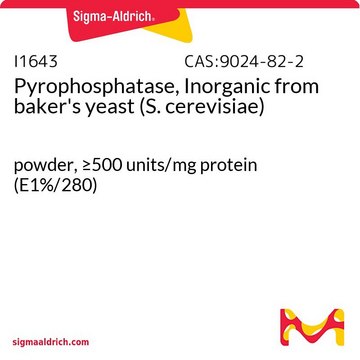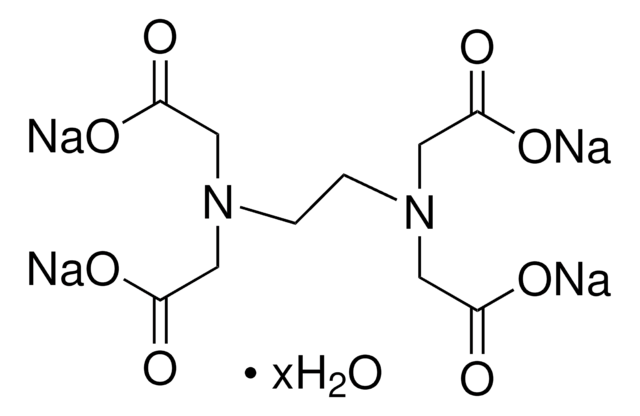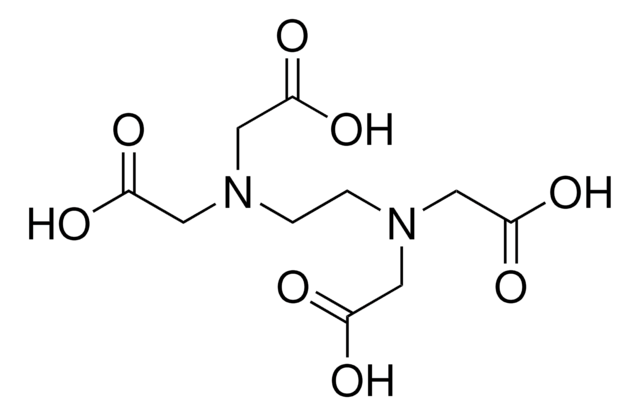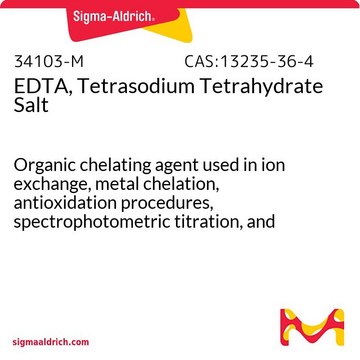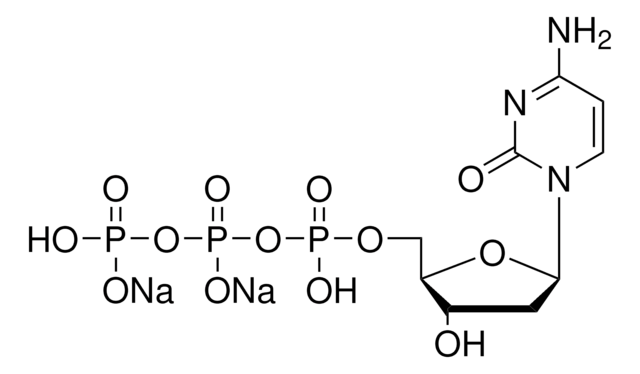83205
Pyrophosphatase, Inorganic from baker′s yeast (S. cerevisiae)
powder, off-white, ~70 U/mg
Synonym(s):
Inorganic Pyrophosphatase, Pyrophosphate phosphohydrolase
Sign Into View Organizational & Contract Pricing
All Photos(1)
About This Item
Recommended Products
form
powder
specific activity
~70 U/mg
mol wt
Mr ~71000
color
off-white
storage temp.
−20°C
Looking for similar products? Visit Product Comparison Guide
General description
Molecular Weight: 71 kDa (homodimer consisting of two equal subunits of molecular weight 32-35 kDa)
Extinction Coefficient: E1% = 14.5 (280 nm)
pI: 4.75
This ubiquitous enzyme serves to drive metabolic reactions that produce pyrophosphate, since these reactions typically have equilibrium constants near unity. The catalytic mechanism has been described in the literature. Inorganic pyrophosphatase is a metalloprotease that requires Mg2+ for maximal activity. Although the hydrolysis of inorganic pyrophosphate is specific in the presence of Mg2+, both ADP and ATP can be hydrolyzed if zinc is present.
Extinction Coefficient: E1% = 14.5 (280 nm)
pI: 4.75
This ubiquitous enzyme serves to drive metabolic reactions that produce pyrophosphate, since these reactions typically have equilibrium constants near unity. The catalytic mechanism has been described in the literature. Inorganic pyrophosphatase is a metalloprotease that requires Mg2+ for maximal activity. Although the hydrolysis of inorganic pyrophosphate is specific in the presence of Mg2+, both ADP and ATP can be hydrolyzed if zinc is present.
Application
Inorganic pyrophosphatase (PPase) is a ubiquitous enzyme catalyzing the reaction PPi + H2O → 2Pi.
It plays an important role in protein, RNA, and DNA synthesis.
It plays an important role in protein, RNA, and DNA synthesis.
Unit Definition
1 U corresponds to the amount of enzyme which will liberate 1 μmol of phosphate from inorganic pyrophosphate per minute at pH 7.2 and 25 °C
Other Notes
Mechanism of action
Storage Class Code
13 - Non Combustible Solids
WGK
WGK 3
Flash Point(F)
Not applicable
Flash Point(C)
Not applicable
Personal Protective Equipment
dust mask type N95 (US), Eyeshields, Gloves
Regulatory Information
新产品
Choose from one of the most recent versions:
Certificates of Analysis (COA)
Lot/Batch Number
Sorry, we don't have COAs for this product available online at this time.
If you need assistance, please contact Customer Support.
Already Own This Product?
Find documentation for the products that you have recently purchased in the Document Library.
The mechanism of action of yeast inorganic pyrophosphatase.
B S Cooperman
Methods in enzymology, 87, 526-548 (1982-01-01)
Manhong Yao et al.
Molecular biology reports, 39(8), 7989-7996 (2012-04-28)
According to sequences of H(+)-pyrophosphatase genes from GenBank, a new H(+)-pyrophosphatase gene (KfVP1) from the halophyte Kalidium foliatum, a very salt-tolerant shrub that is highly succulent, was obtained by using reverse transcription PCR and rapid amplification of cDNA ends methods.
Eric E Hernández-Domíguez et al.
Plant science : an international journal of experimental plant biology, 187, 39-48 (2012-03-13)
Phosphorus is an essential element for all living cells, but its availability is often limiting in the soil. Plants have adapted to such limitation and respond to phosphorus deficiency. The soluble inorganic pyrophosphatases (PPase; EC 3.6.1.1) recycle the pyrophosphate produced
Jing-Jing Xiang et al.
Plant physiology, 159(4), 1488-1500 (2012-06-21)
Leaf rolling is an important agronomic trait in rice (Oryza sativa) breeding and moderate leaf rolling maintains the erectness of leaves and minimizes shadowing between leaves, leading to improved photosynthetic efficiency and grain yields. Although a few rolled-leaf mutants have
H Y Lin et al.
Diabetologia, 55(10), 2703-2712 (2012-07-20)
The transcription factor, forkhead box (FOX)O1, is involved in fatty acid-induced apoptosis in pancreatic beta cells, but the precise mechanism is poorly understood. We aimed to identify which direct downstream targets of FOXO1 are involved in palmitate-induced apoptosis in the
Our team of scientists has experience in all areas of research including Life Science, Material Science, Chemical Synthesis, Chromatography, Analytical and many others.
Contact Technical Service